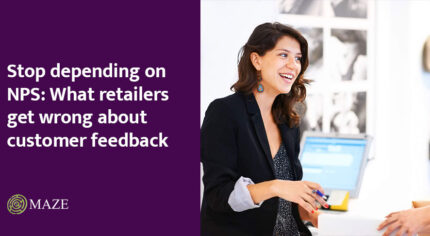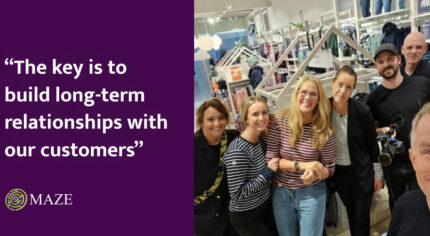
Feedback
Retail Week Live 2022: Insights from retailers on CX, personalisation and the future of loyalty
Technology is changing society.
How we work, socialise and shop is evolving. There is no aspect of our existence which isn’t becoming more digital. And the retail industry is at the epicentre of this global transformation.
The digital habits of consumers blossomed through the pandemic – with ecommerce sales soaring across every category. Research from BRC/KPMG Retail Sales Monitor revealed that close to half of non-food retail sales in the UK (46.9%) took place online during 2021.
These online shopping behaviours are pervasive. But this digital transformation isn’t just about buying stuff online. It represents an ongoing revolution of experience – a period of rapid evolution in how brands and consumers interact.
And these experiences are compared across categories. Retailers aren’t just competing with their immediate rivals – they are competing with Netflix, Disney, Amazon. When the bar rises in one sector, it raises expectations across all sectors.
In this dynamic environment, physical stores remain a crucial part of the user journey. People still want to shop physically – UK Government figures show that the proportion of online retail sales fell to 25.3% in January 2022 – the lowest since the lockdowns introduced in March 2022.
Physical stores remain hugely important to consumers. But digital transformation is changing expectations. Retailers need to closely craft and control their in-store experience to meet – and exceed – the expectations of modern shoppers.
At Retail Week 2022, Maze Feedback sat down for an exclusive roundtable session with a host of leading UK retailers. The session explored the opportunities for technology to supercharge the in-store experience for retailers, customers – and employees.
In this report, we’ve captured the key questions retailers are asking – and the major themes which will shape the in-store experience for retailers in the coming years.
We hope you find these insights useful.
Experience as a competitive advantage
Experience is a powerful differentiator for retailers. Research shows that 49% of consumers have left a brand in the past year due to poor customer experience.
Business leaders know how influential experience is. But although 87% of senior business leaders in the US and UK see experience as the ‘top growth engine’ – only 1 in 3 are actively addressing it.
At our Maze Roundtable at RWL2022, Celin Kjenslie, Head of Consumer Insight and Strategy at REMA 1000, kicked off the session by exploring how technology is putting the retailer in control of its customer experience – and giving it an advantage over competitors.
“In Norway there is fierce competition for groceries,” Celin opened. “The average customer has four chains all immediately within distance of their work or home. All of these stores have similar pricing, similar products and similar marketing. So how do you stand out? How do you convince a customer to walk past three other stores before entering yours?”.
“The answer is to drive loyalty through your in-store experience,” Celin summarised. “Experience is the strongest protection against disruption and competition. And that’s why we work with Maze.”.
Maze Feedback is an AI driven training app. Maze empowers staff to improve by providing staff with personalised feedback from real customers, alongside AI powered training, on a daily basis. This real-time feedback loop creates positive new behaviours, personalised to each employee and each store, allowing retailers to perfect their in-store customer experience.
Celin explained how the grocer had leveraged Maze Feedback’s technology to gain close control of its customer experience. “Often in corporate roles you are distanced from the true in-store experience – the real feeling of daily customer interactions. So while most of our competitors are focusing on increasing marginal efficiencies in payments and checkouts – we chose to focus on integrating feedback systems which illustrate how employees can improve customer experience on a daily basis.”.
The retailers around the table listened intently before asking a series of questions.
“What share of checkouts are from identified customers?” asked one retail chief.
“The vast majority,” answered Celin. “We have an app that sits at the centre of our omnichannel strategy. Customers receive personalised offers based on their location and loyalty – and it gives customers the chance to feedback. This feedback is what powers Maze, tailors our training and informs how we shape our CX”.
“And how many physical checkouts per review given?” asked the same retailer.
Celin had her numbers to hand. “We get feedback from 25% of customers who have signed up for the app. Within our first few months of introducing Maze and the app to our stores, we have received over 100,000 unique pieces of feedback directly from our customers. This highly engaged feedback is the fuel for Maze’s AI powered personalised training for staff. But it is also first party data – which is a lucrative boost for our marketing.”
“What is the incentive for customers to engage with the app and feedback?” asked another attendee.
“We often use gift cards where customers can win prizes if they give feedback,” explained Celin. “But we’ve seen that customers tend to proactively give feedback regardless. It works better for us than pestering segments of our audience with surveys every 90 days – now customers can give feedback on the things that matter to them on their own schedule.”
“And what kind of business metrics do you get from these interactions?”
“We look at our degree of ambassadors from our customer base – customers who would advocate and recommend our brand to their peers. This gives us an insight into the levels of customer satisfaction – and with Maze’s systems in place, our analysis shows us what is driving customer satisfaction in each store. And where the opportunities for improvement lie.”
“No two stores are the same,” Celin summarised. “All of our shopkeepers have different focuses depending on who you are, where you are and who you serve. Equipped with this data, our people can sharpen their strengths and mitigate their weaknesses.”
“How do you avoid discounting endlessly to maintain loyalty? Or in other words, how does loyalty live beyond access to discounts?” asked a senior British retailer as the first session closed.
“Discounting alone is not a strategy which is viable in the long-term. Loyalty is something more than just regularly leveraging discounts,” noted Celin. “The answer to this question is personalisation. Discounts are a means to get closer to our customers and what they need – we can then take this insight and shape our in-store experiences to meet and exceed the expectations of these shoppers. But the personalisation has to be done correctly.”
Personalisation and gamification
Personalisation is a powerful tool for modern businesses. Data empowers retailers and brands to get closer to their customers – to be proactive and helpful forces shaping their journey to purchase, as opposed to being passive and reactive.
But personalisation is not a one-dimensional force only to be exerted on customers. By offering staff personalised feedback and training, retailers empower their people to develop and encourage them to take pride and ownership of the brand experience.
The importance of engaged, helpful staff cannot be understated. Research from PWC shows that 65% of consumers find a positive interaction with a brand to be more influential than great advertising – while 56% of consumers say that the quality of the customer service they receive has a higher impact on how positively they view a brand than any other criteria.
Perhaps most importantly, 64% of consumers will pay at least 5% more if they know they will have a good customer experience.
People buy people before they buy products. As Celin and REMA 1000 noted in the opening session, providing excellent customer service elevates customers to ambassadors.
Staff are one of the most important sales channels. They are the physical, human embodiment of a brand. But, just as with Google Shopping or Amazon, these channels must be optimised and supported on a daily basis in order to provide the best results.
“So how can we encourage staff to engage and implement the feedback they are given?” asked one retailer.
“Everyone has individual strengths and weaknesses. Some stores will have staff which have outstanding product knowledge and cleanliness – but others may excel in friendliness and speed of service,” answered Celin. “But business leaders should understand that the vast majority of staff actively want to do a good job. They want support structures in place which help them learn and develop. People are receptive to initiatives which help them grow.”
“Does gamification play a role in encouraging staff to engage with feedback?” followed another retail leader.
“Yes – and it is powerful because it speaks to our innate ambitions as humans” Celin replied.
“We all know how gamification works from a consumer POV. A coffee club reward scheme adds layers to your relationship with a brand, giving a sense of value – which drives loyalty and creates a long term bond.”
“But there is a huge opportunity for retailers to leverage these same qualities with their own staff. Maze creates leaderboards which allows staff to see how they rank against their peers – and stores to see how they compare with other outposts. Access to this information increases staff engagement and encourages development by giving those who go above-and-beyond recognition.”.
Turning experience into loyalty
Personalisation, gamification and control of the in-store experience are all effective measures. But the ultimate goal of these tactics is to drive customer loyalty. And loyal customers are the most valuable thing a retailer can have.
A key takeaway from the retailer roundtable at RWL2022 was the recognition of the importance of human interaction in shaping a brand experience. Technology is changing every aspect of our society – but it isn’t replacing human-to-human contact. It’s supercharging it.
Staff shouldn’t be viewed as a mass collective. Each teammate is unique. And when people are equipped with the tools, information and training they individually need – they become your biggest competitive advantage.
To learn more about how Maze Feedback can put you in charge of your in-store experience, get in touch at mark.rice@mymaze.com.




